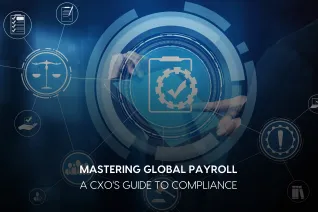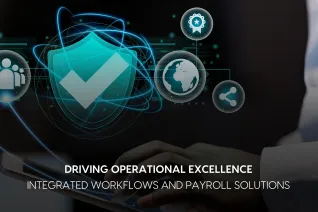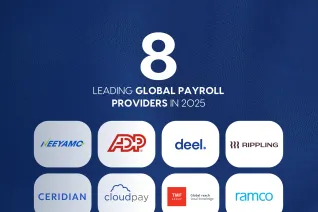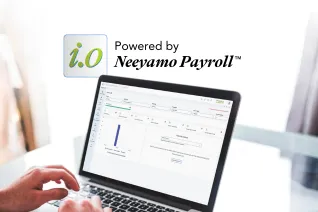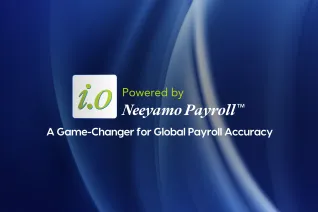The Role of Artificial Intelligence in Global Payroll

What is Artificial Intelligence?
Artificial intelligence (AI) empowers computers to learn, think, and solve problems like humans. By crunching vast data, they can identify patterns, make decisions, and even create. From optimizing global payroll technology to aiding doctors, AI is transforming every field, one bit at a time.
Artificial Intelligence (AI) is everywhere. Generative AI technology, like ChatGPT and Dall-e, has gained significant popularity and has taken various industries by storm, including HR transformation.
Using AI from an HR standpoint has several benefits, especially in payroll processing. From automating data collection to performing checks, AI can help identify patterns, trends, and anomalies in payroll data.
Providing insights on the benefits of AI in HR and payroll, the implementation of the technology, and how to leverage it are Shakil Gour, Vice President and Head of Global Payroll at Neeyamo, and Yegnaswamy Yegnanarayanan, CEO at NeeyamoWorks.
The AI effect in the HR world
Talking about the use cases of AI in HR, Shakil says that it can contribute to building a knowledge base for HR-related queries, enabling self-service for employees and payroll administrators.
Integrating generative AI into existing systems can enhance the efficiency of HR operations. “Take our own ServiceDesk, for instance,” he says. “The technology relies on machine learning but can be customized and trained for specific purposes.”
While it is a platform to raise and solve queries, it would prove to be more efficient if AI is leveraged to build corresponding knowledge bases. From an HR standpoint, such knowledge bases can help users to prioritize the most helpful responses.
Also Read | Embracing Innovation: How HR Technology Can Benefit from Blockchain, RPA, AI, and ML
“Building a knowledge repository for payroll that captures all the trigger points for different countries enables easy access to relevant information,” YY adds. For payroll, automation and training the system to be self-learning can help handle statutory changes effectively.
By leveraging machine learning algorithms, these knowledge bases can minimize the need to raise queries. “Such AI-powered solutions can significantly reduce operational inefficiencies and costs,” adds Shakil.
A step further in payroll
AI systems can also assist in making payroll calculations more efficient by analyzing large volumes of data faster and more precisely. Even currently, the system has certain limitations, and YY observes that leveraging AI and robotics could improve operational efficiency.
“There are challenges posed by changing taxation laws and regulations. If we could automate the process of gathering and updating information from other sources, such as government websites and WhatsApp groups. Then it can help ensure accurate and timely payroll calculations,” he adds.
Also Read | Next-Generation Payroll Technology: Embracing the Era of Autonomous Global Payroll
The question arises, now that Neeyamo has taken a step forward, from automating the payroll process to making it hyper-automated and bringing in a ‘No Touch, Low Touch’ system with Neeyamo PayrollTM 3.0, how practical will the implementation of autonomous global payroll be?
To this, Shakil has the answer, “For organizations like Neeyamo that have native engines and their own technology stack, it is a matter of flexibility. They can adapt to technological changes and have an advantage when implementing a global touchless payroll solution.” Though he recognizes the complexity of such a solution, he also identifies that readiness to adapt to technology is crucial.
YY also agrees that overall technological adoption trends will drive the adoption of touchless payroll. “The availability of automated solutions for payroll calculations and employee payouts makes it feasible to achieve 100% automation in these areas,” he says.
ALSO READ | Global Payroll: 10 Trends that will be prominent in 2023
How will AI help in mitigating payroll risks and complexities?
Compliance, integration, and data security remain concerns in the payroll processes regardless of the level of automation. “While we have made progress in automating simpler functions, there is still a certain level of complexity in configuring country-specific rules,” says YY.
He also highlights the need to address more complex scenarios and continuously update the system with a structured approach.
If implemented effectively, adopting and transitioning to autonomous global payroll can significantly improve efficiency and reduce costs while enhancing employee experience and self-sufficiency.
The Neeyamo Payroll 3.0 effect
Leveraging generative AI and predictive analytics can prove to be beneficial in HR as well as payroll operations. Integrating AI in HR processes can enable proactive and self-service solutions. They can also enhance payroll operations by streamlining tasks, automating data processing, and providing valuable insights through data analysis.
And Payroll 3.0 is an unmatched global solution that will bring the concept of autonomous global payroll to life by implementing this technology. It delivers a hyper-automated, comprehensive, and fully integrated global payroll solution that meets every payroll need of organizations worldwide.
Propel your payroll operations forward and join the technology revolution today. Reach out to the experts at irene.jones@neeyamo.com.
Latest Resources
Stay informed with latest updates
If you're curious and have a thirst for knowledge pertaining to the HR, payroll, and EOR universe, don't miss out on subscribing to our resources.




